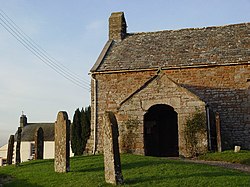Clifton, Westmorland
| Clifton | |
| Westmorland | |
|---|---|
 Old Church | |
| Location | |
| Grid reference: | NY535265 |
| Location: | 54°37’53"N, 2°43’19"W |
| Data | |
| Population: | 497 (2011) |
| Post town: | Penrith |
| Postcode: | CA10 |
| Dialling code: | 01768 |
| Local Government | |
| Council: | Westmorland & Furness |
| Parliamentary constituency: |
Penrith and The Border |
Clifton is a small, linear village in Westmorland, three miles south-east of Penrith (across the county border in Cumberland), with the western boundary of the parish defined by the River Lowther.
The village of has a church, primary school, and a pub.
Most of the hamlet of Clifton Dykes is also within the parish. The hamlet is named Longchimney on the first edition Ordnance Survey map of 1897, and then as Clifton Dikes on the later second edition. The current spelling was settled on more recently.
History
Clifton Dykes has been suggested as the (pre-Roman conquest) centre of the Carvetti, an Iron Age and Roman-period 'tribe', one that possibly led a resistance against Roman forces in A.D. 69 under the leadership of Venutius.[1] This is based upon the evidence of a large (c.7 acre) Iron Age enclosure discovered there, plus assumptions about its strategic importance on the Eden Valley communication routeway. However, this has been disputed: the Carvetii may have always been centred on Carlisle even before the Romans established Luguualium (Carlisle) and Venutius may not have been Carvetiian.[2]
The Battle of Clifton Moor
Clifton Moor was the site, in 1745, of the last battle ever fought on English soil; not a pitched battle, but a skirmish, fought between Charles Stuart, the Young Pretender known as 'Bonnie Prince Charlie' and the Duke of Cumberland, as Pretender's forces withdrew into Scotland.
The story of a local family, the Wybergs, whose property was forcibly sold by Oliver Cromwell in 1652, is told in Sir Walter Scott's novel, Waverley, which also features the battle on Clifton Moor.
St Cuthbert's church
The parish church, St Cuthbert's, contains the graves of 10 men killed in battle of Clifton Moor. (The Scots dead are, reputedly, buried beneath a tree towards the southern end of the village). A local traditional claims that some of the remains of St Cuthbert are also said languishing in the church (although this defies the results of the Victorian examination of the saint's body in Durham).
St Cuthbert's church contains a monument to a local benefactress, Eleanor Engayne, who died about the year 1395 ; according to the Topography and Directory of Westmorland, 1851, the manor of Clifton was given in the reign of Henry II, by Hugh de Morville, one of Thomas Becket's murderers, to Gilbert de Engayne, with whose descendants it continued till their heiress, Eleanor, in 1364, carried it in marriage to William de Wyberg.[3]
Transport
There once were two railway stations, the 1846 Clifton station (later named Clifton and Lowther railway station) was on the Lancaster and Carlisle Railway (now part of the West Coast Main Line); It closed to passengers in 1938.[4]
Another station, called Clifton Moor, was on the Eden Valley Railway and opened 1863, closing in 1962.[5] Confusingly Clifton & Lowther Station was at a hamlet known as Clifton Moor. The nearest station is now Penrith.
The West Coast Mainline railway crosses the River Lowther on 'Hugh's Crag Viaduct', better known as Lowther Viaduct,[6] or Clifton Viaduct,[7] built in 1846.[8]
The M6 motorway now also runs through the parish.
Other
Wetheriggs Pottery is to the east of the village.
Clifton Hall, a 15th-century pele tower, stands by the village.
Outside links
| ("Wikimedia Commons" has material about Clifton, Westmorland) |
- Megalithic Portal: Clifton Standing Stones
- Clifton - Moor - "The Battle of" Contemporary account of the Battle of Clifton Moor by Thomas Savage, of Clifton End Farm, 1745, via edenlinks.rootsweb.com
- Clifton Hall
References
- ↑ Higham, N.J.; Jones, G.D.B. (1985). The Carvetii. Peoples of Roman Britain. Stroud: Alan Sutton. pp. ix, 158, p.10. ISBN 0862990882.
- ↑ Ross, Catherine (2012). "The Carvetii - a pro-Roman community?". Transactions of the Cumberland and Westmorland Antiquarian and Archaeological Society. 3 12: 55–68.
- ↑ Clifton , Extract from the History, Topography and Directory of Westmorland , Mannix & Co. , 1851 , via www.stevebulman.f9.co.uk
- ↑ Clifton and Lowther www.disused-stations.org.uk
- ↑ Clifton Moor www.disused-stations.org.uk
- ↑ Opening of the Lancaster and Carlisle Railway Tuesday Last, The Illustrated London News, 19 December 1846, (online reprint) , also reprinted in Nineteenth-Century railway history through the Illustrated London news, Anthony J. Lambert, 1984
- ↑ Hugh's Crag Viaduct, Yanwath and Eaton Bridge - British Listed Buildings
- ↑ Lowther Viaduct www.engineering-timelines.com
- History, topography, and directory, of Westmorland: and Londsdale north of the sands, in Lancashire together with a descriptive and geological view of the whole of the Lake district, P. J. Mannex, 1849, "Clifton Parish" pp. 218–219, other pages, google books
